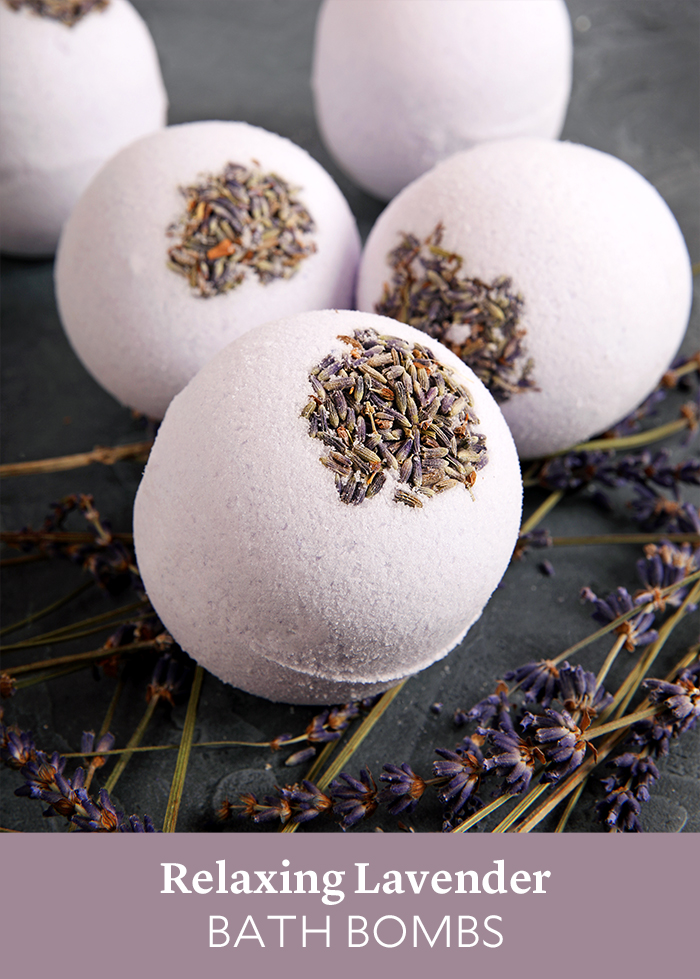
This recipe has everything you need to relax after a long day. It’s made with lavender 40/42 essential oil, borage oil, and Epsom salt. The dried lavender on top is a simple finishing touch that makes the bath bombs perfectly giftable.
Borage oil is lightweight and has amazing skin-loving properties. To help it mix into your bath, we added a bit of polysorbate 80. It’s an emulsifier that helps the oil mix into the water rather than pooling on top. It’s an optional ingredient, but we love the way it makes the water feel.
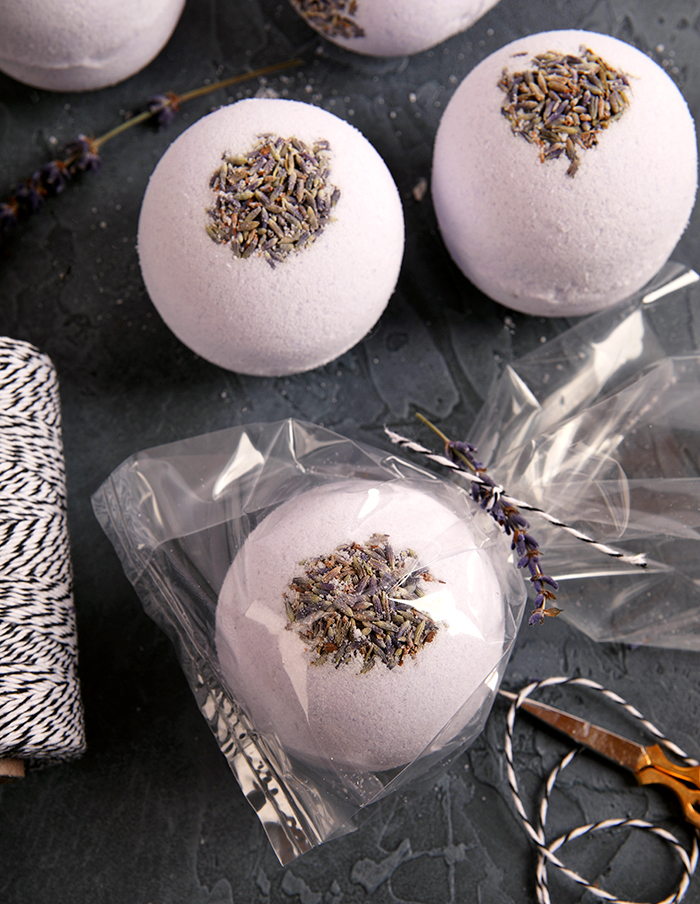
The light purple hue comes from Lilac La Bomb Colorant. La Bomb Colorants are specifically formulated for bath bombs – they’re made with water-soluble glycerin, which prevents a ring of color around the tub. Feel free to add more drops for a more saturated color.
What You Need: Click below to add everything you need for this project to your Bramble Berry shopping cart!Relaxing Lavender Bath Bombs
Stainless Steel Bath Bomb Mold
32 oz. Baking Soda
16 oz. Citric Acid
4 oz. Extra Fine Epsom Salt
2 oz. Borage Oil
0.7 oz. Polysorbate 80
0.3 oz. Lavender 40/42 Essential Oil
About 12 drops Lilac La Bomb Colorant
Dried Lavender
Witch Hazel in a Spray Bottle
ONE: In a small container, add 2 ounces of borage oil, 0.7 ounces of polysorbate 80, 0.3 ounces of lavender 40/42 essential oil, and about 12 drops of Lilac La Bomb Colorant. Use a spoon to thoroughly mix all the ingredients together. The colorant won’t incorporate fully, but that’s okay.
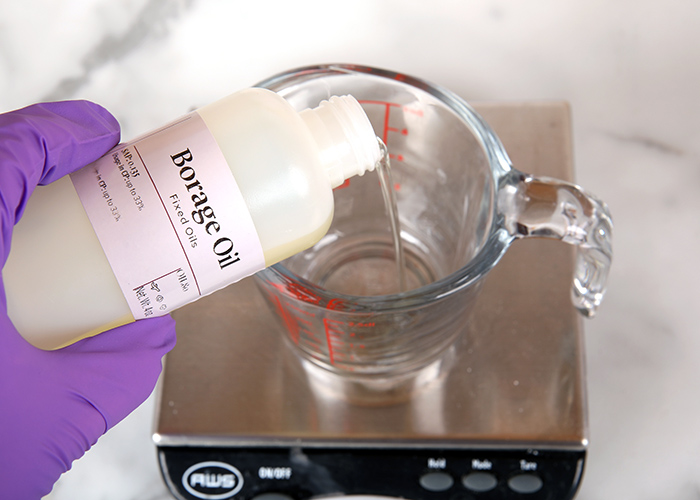
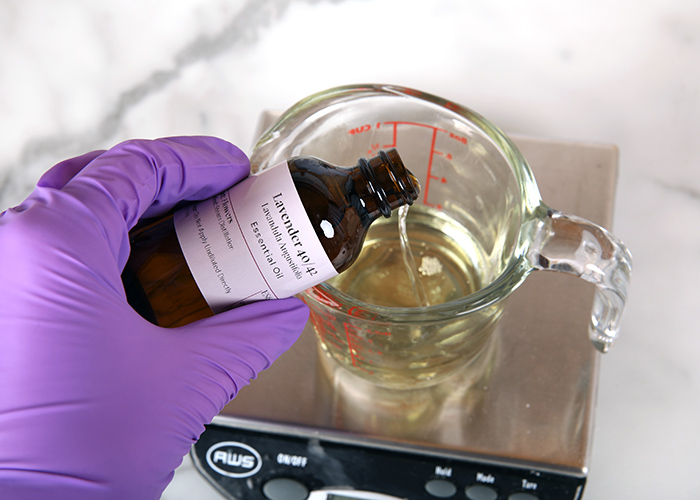 TWO: In a large container, add 32 ounces of baking soda and 16 ounces of citric acid. To get rid of clumps, push the powder through a sifter or break them up with your fingers. Citric acid has a tendency to take off nail polish, so wear gloves to protect your manicure. Add 4 ounces of Epsom salt. Thoroughly stir the ingredients together.
TWO: In a large container, add 32 ounces of baking soda and 16 ounces of citric acid. To get rid of clumps, push the powder through a sifter or break them up with your fingers. Citric acid has a tendency to take off nail polish, so wear gloves to protect your manicure. Add 4 ounces of Epsom salt. Thoroughly stir the ingredients together.
THREE: Add the oil to the dry ingredients. Use your hands to thoroughly mix the dry and wet ingredients together.
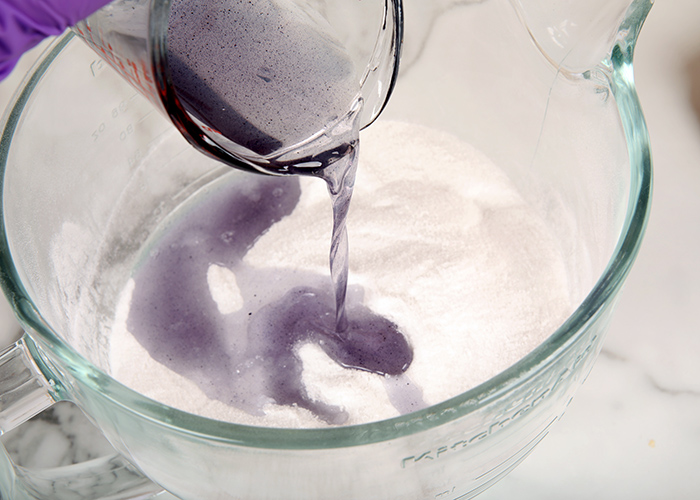
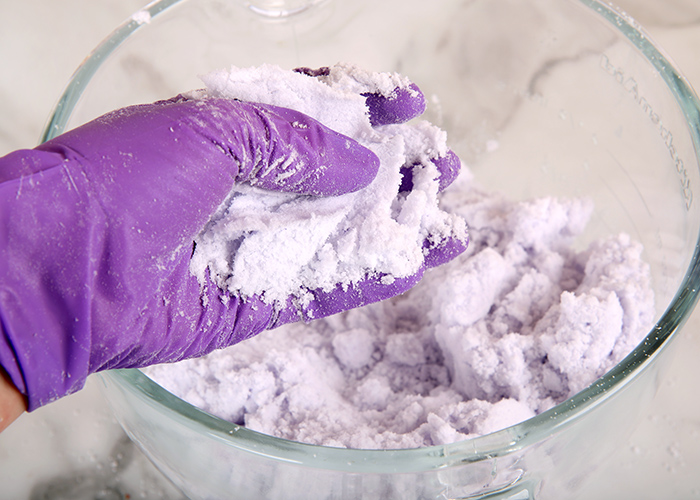
FOUR: Check the consistency of the bath bomb mixture. The perfect consistency is similar to wet sand that holds its shape when squeezed. If it’s too dry, use one hand to spritz the mixture with witch hazel and one to mix. Continue spritzing until the mixture holds its shape.
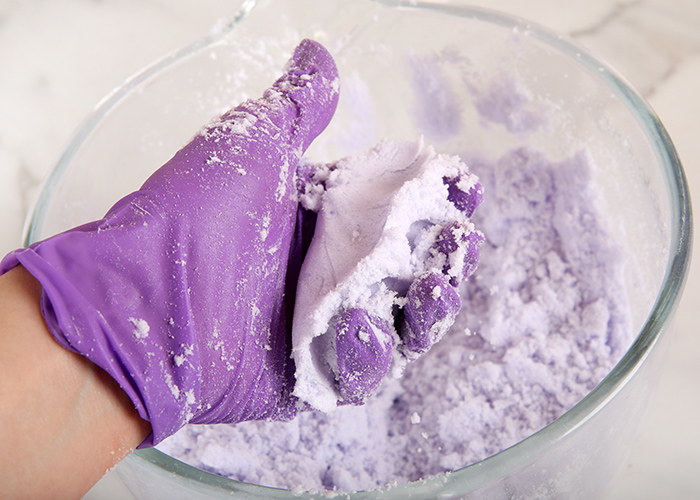 FIVE: Place a pinch of dried lavender in the center of one half of the Stainless Steel Bath Bomb Mold.
FIVE: Place a pinch of dried lavender in the center of one half of the Stainless Steel Bath Bomb Mold.
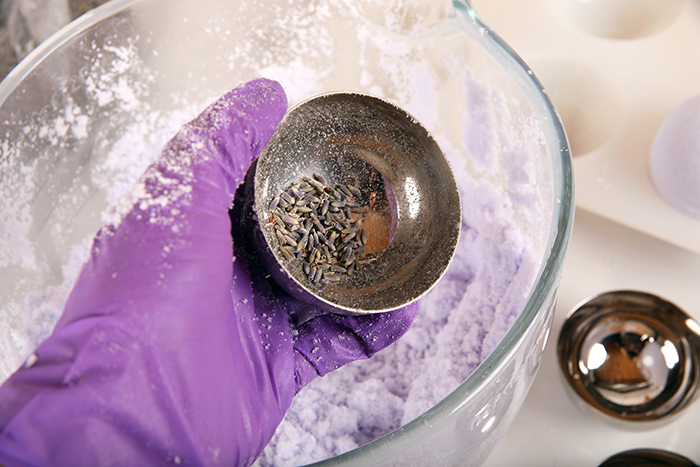 SIX: Fill both halves of the mold with bath bomb mixture and press it into the molds. You don’t need to press too hard – it helps the bath bomb halves stick together if some of the mixture is loose on top. Once both halves are full, press them firmly together.
SIX: Fill both halves of the mold with bath bomb mixture and press it into the molds. You don’t need to press too hard – it helps the bath bomb halves stick together if some of the mixture is loose on top. Once both halves are full, press them firmly together.
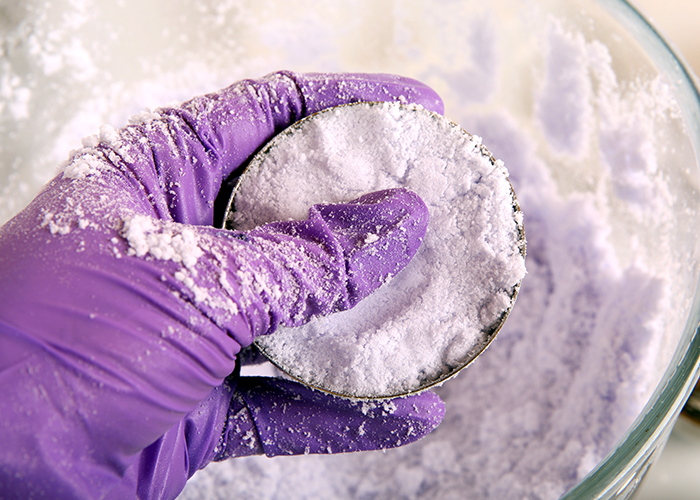
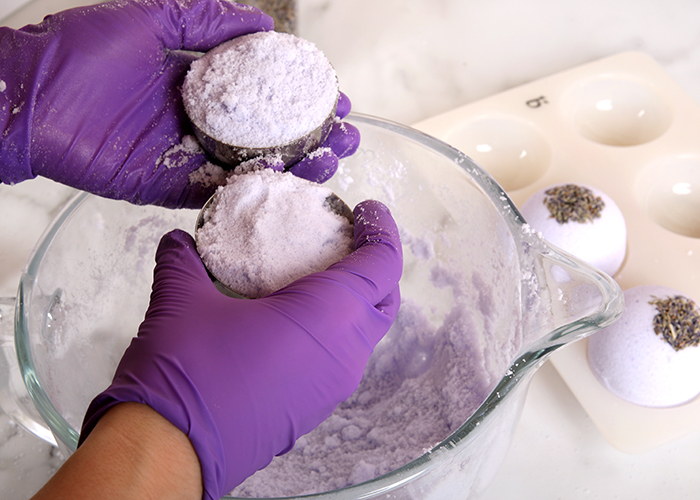 SEVEN: Very gently, pull the top half of the mold away while twisting. It can be a little tricky to get the bath bombs to stick together, but practice makes perfect. To safely unmold the other half, place the top of the mold back on, flip the bath bomb over, and release the other side by twisting and pulling away gently.
SEVEN: Very gently, pull the top half of the mold away while twisting. It can be a little tricky to get the bath bombs to stick together, but practice makes perfect. To safely unmold the other half, place the top of the mold back on, flip the bath bomb over, and release the other side by twisting and pulling away gently.
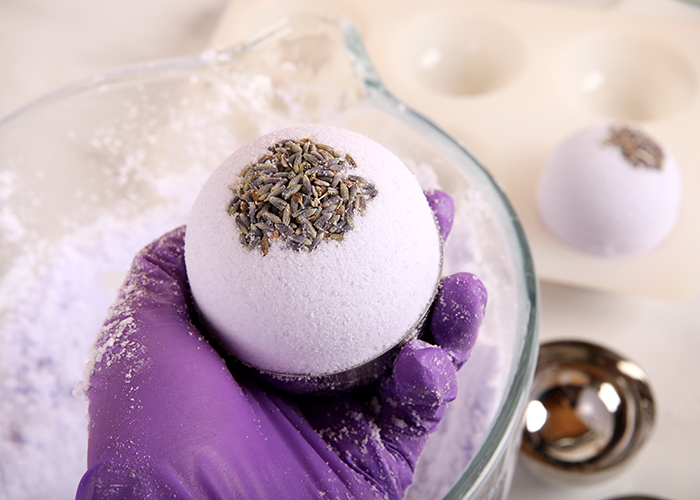 EIGHT: Place the bath bomb on the counter or in a container that will hold them in place without rolling away. We used the 6 Cavity Silicone Dome Mold. You can also use a large muffin tin or a soft surface like foam. Allow the bath bombs to fully dry and harden overnight. Once you’re ready to use, place in hot bath water and enjoy!
EIGHT: Place the bath bomb on the counter or in a container that will hold them in place without rolling away. We used the 6 Cavity Silicone Dome Mold. You can also use a large muffin tin or a soft surface like foam. Allow the bath bombs to fully dry and harden overnight. Once you’re ready to use, place in hot bath water and enjoy!
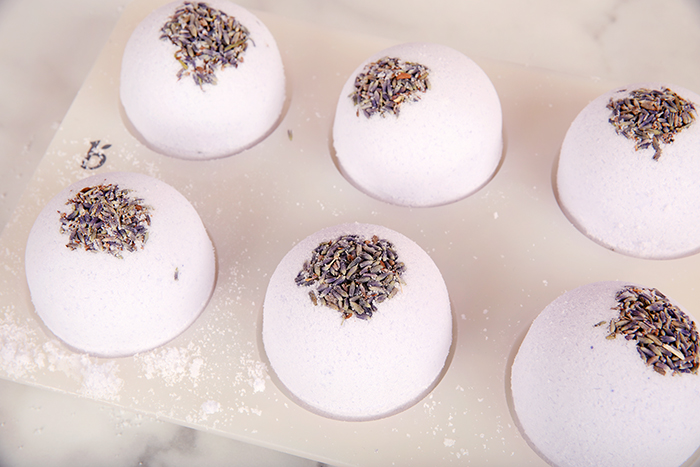
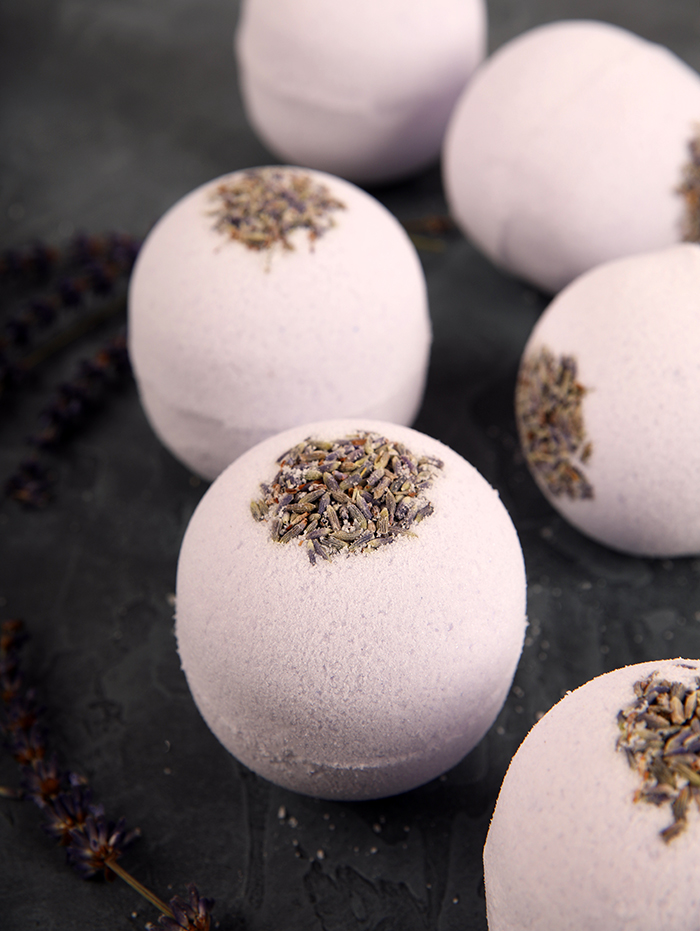
- Stainless Steel Bath Bomb Mold
- 32 oz. Baking Soda
- 16 oz. Citric Acid
- 4 oz. Extra Fine Epsom Salt
- 2 oz. Borage Oil
- 0.7 oz. Polysorbate 80
- 0.3 oz. Lavender 40/42 Essential Oil
- About 12 drops Lilac La Bomb Colorant
- Dried Lavender
- Witch Hazel in a Spray Bottle
- In a small container, add 2 ounces of borage oil, 0.7 ounces of polysorbate 80, 0.3 ounces of lavender 40/42 essential oil, and about 12 drops of Lilac La Bomb Colorant. Use a spoon to thoroughly mix all the ingredients together. The colorant won’t incorporate fully, but that’s okay.
- In a large container, add 32 ounces of baking soda and 16 ounces of citric acid. To get rid of clumps, push the powder through a sifter or break them up with your fingers. Citric acid has a tendency to take off nail polish, so wear gloves to protect your manicure. Add 4 ounces of Epsom salt. Thoroughly stir the ingredients together.
- Add the oil to the dry ingredients. Use your hands to thoroughly mix the dry and wet ingredients together.
- Check the consistency of the bath bomb mixture. The perfect consistency is similar to wet sand that holds its shape when squeezed. If it’s too dry, use one hand to spritz the mixture with witch hazel and one to mix. Continue spritzing until the mixture holds its shape.
- Place a pinch of dried lavender in the center of one half of the Stainless Steel Bath Bomb Mold.
- Fill both halves of the mold with bath bomb mixture and press it into the molds. You don’t need to press too hard – it helps the bath bomb halves stick together if some of the mixture is loose on top. Once both halves are full, press them firmly together.
- Very gently, pull the top half of the mold away while twisting. It can be a little tricky to get the bath bombs to stick together, but practice makes perfect. To safely unmold the other half, place the top of the mold back on, flip the bath bomb over, and release the other side by twisting and pulling away gently.
- Place the bath bomb on the counter or in a container that will hold them in place without rolling away. We used the 6 Cavity Silicone Dome Mold. You can also use a large muffin tin or a soft surface like foam. Allow the bath bombs to fully dry and harden overnight. Once you’re ready to use, place in hot bath water and enjoy!
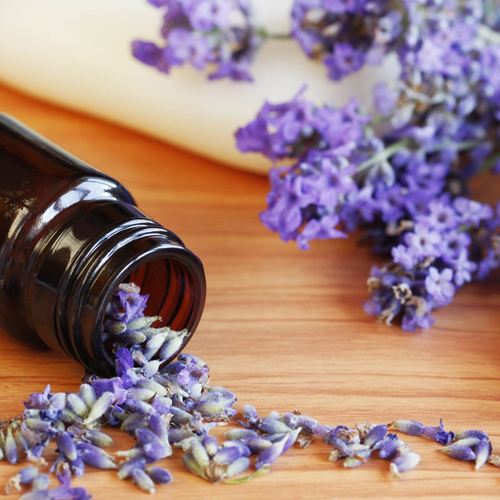
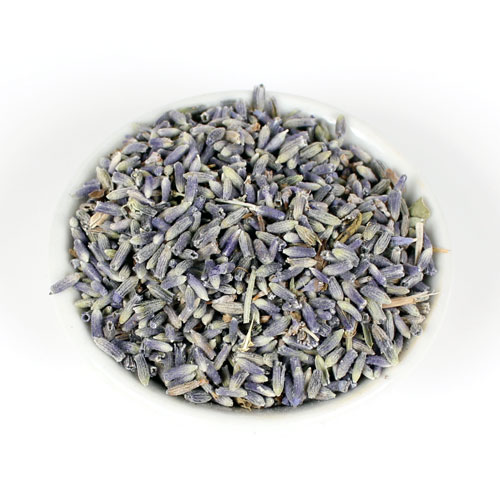

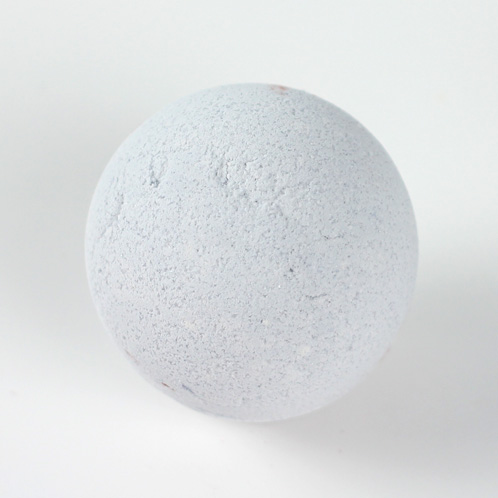


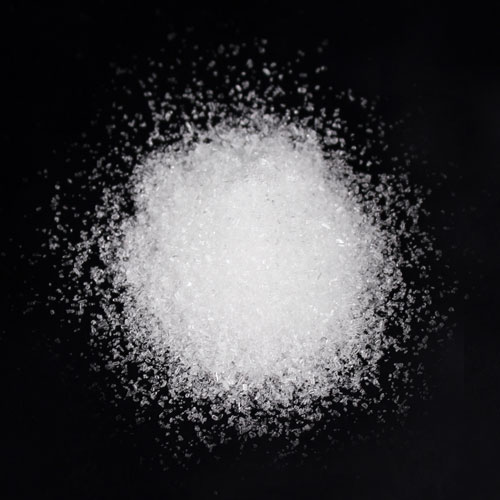
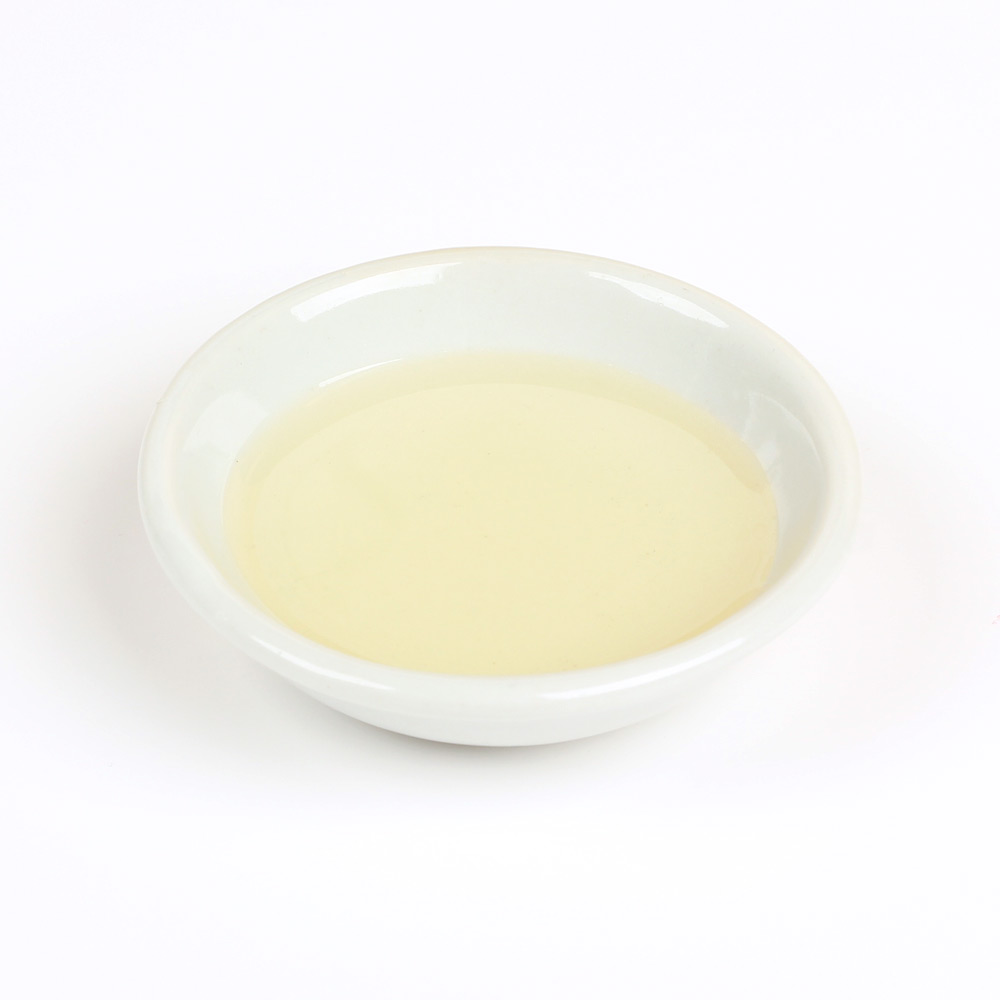

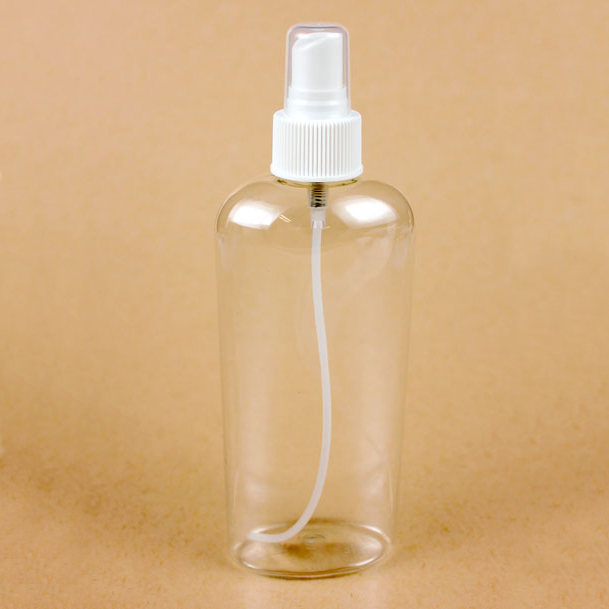
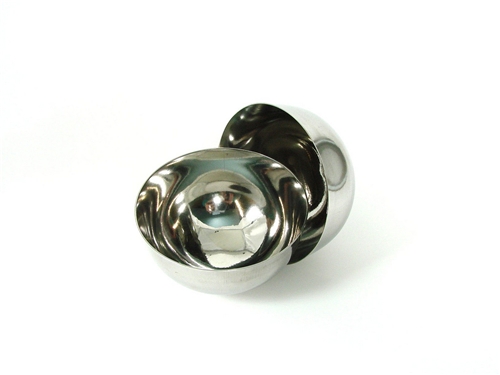
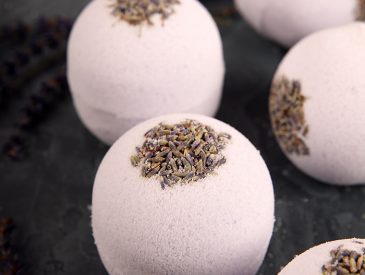
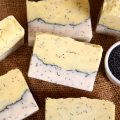

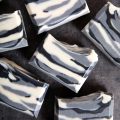

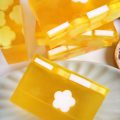
Hi Anne Marie
I followed this recipe to the T using a scale and after 18 hours all my bath bomb fell apart when I tried to remove the last half of the bomb mold….. they looked beautiful up until then. should I add cornstarch or clay and try to remold? or is dryness a factor? they dont feel dry.
wondering why this happened when the other 3 recipes I did seemed to work fine. perhaps the oil @3 tbsp was a better ratio?
thanks
lee
Clay works to help keep them together. If they feel wet you might want to work in a different location as humidity can cause them to fall apart and fizz prematurely. Also too much oil in a warm environment could also make it so they don’t want to stick together.
I would like to omit the oil completely to reduce the risk of creating a slippery tub, would I no longer need the poly80 if i did that?
Thanks
Erin
Yes, the Polysorbate 80 is to help blend the oils in this recipe into your bathwater. If you omit the oil completely you would not need any poly80.
Is the borage oil 2 oz. by volume or by weight? I see that it is being measured on a scale, so I assumed by weight, but it is also being measured into a measuring cup, so perhaps it’s by volume. Please clarify.
The measurements on this project are done by weight in ounces.
Hello how much ingredients would I need to create 100 bath bombs for a Valentine’s party I want to throw? I need to make sure I have enough ingredients.
Thanks!
This particular recipe makes about 7 bombs – if you wanted to make 100 of them, you’d want to purchase enough product to make 15 batches worth.
Thank you!
What is polysorbate 80 substitute? The natural one. Thanks.
We have not found a substitute for Polysorbate 80. You can leave it out but the oils will not blend into the bathwater as much without it, they will more float on the surface of the water.
Hi there! Could I request a tutorial on making bath bombs that float and also a recipe that contains slsa. My bombs always sink! And I cannot seem to find that perfect ratio of slsa to make the bombs fizz and foam at the same time without leaving behind a chunk of bomb. Thanks! ❤️❤️
I will definitely pass along that suggestion for floating bath bombs.
We do have a bath bomb recipe using SLSA though. Aloe Bubble Bath Bombs:
https://www.soapqueen.com/bath-and-body-tutorials/bath-fizzies/aloe-bubble-bath-bombs/
Is there a substitute for the borage oil?
I wanted to know that as well. I wonder if we can use Avocado oil instead for the same amount? Thanks.
You can also use Avocado Oil as a substitute. I would use any substitute you make at the same amount as the Borage Oil listed.
Avocado Oil: https://www.brambleberry.com/Avocado-Oil-P3198.aspx
For a Borage Oil substitute I would recommend a super rich oil like Jojoba.
Jojoba Oil: https://www.brambleberry.com/Jojoba-Oil-Golden-P3219.aspx
Why is there no mention of the epsom salt in the directions? Are they added with the dry ingredients? Can it be made without?
Epsom salts are added to the dry ingredients. They can be made without the salts. Epsom salts, along with soothing/healing properties also act as a water softener. All my bathbombs get epsom salts.
TIP: Epsom salts draw moisture from the air. If you live in a humid climate, this may create some difficulty. Be aware of how much moisture you add while mixing.
The Epsom salt is added in step two. Thanks for catching that mistake, we got the post updated.
Couple of questions – what is the function of polysorbate 80 and can it be omitted. Secondly what could I substitute for borage oil. Thanks
Polysorbate 80 is an emulsifier. It allows oils to mix with water instead of pooling on top. Not necessary, but helps keep oil and colors from sticking to/staining the tub.
Exactly, thanks Roger!
The Polysorbate 80 is used to help the oils used blend into the bathwater. It can be omitted but the oils will float more on the surface of the water.
For a Borage Oil substitute I would recommend a super rich oil like Jojoba.
Polysorbate 80: https://www.brambleberry.com/Polysorbate-80-P4438.aspx
Jojoba Oil: https://www.brambleberry.com/Jojoba-Oil-Golden-P3219.aspx